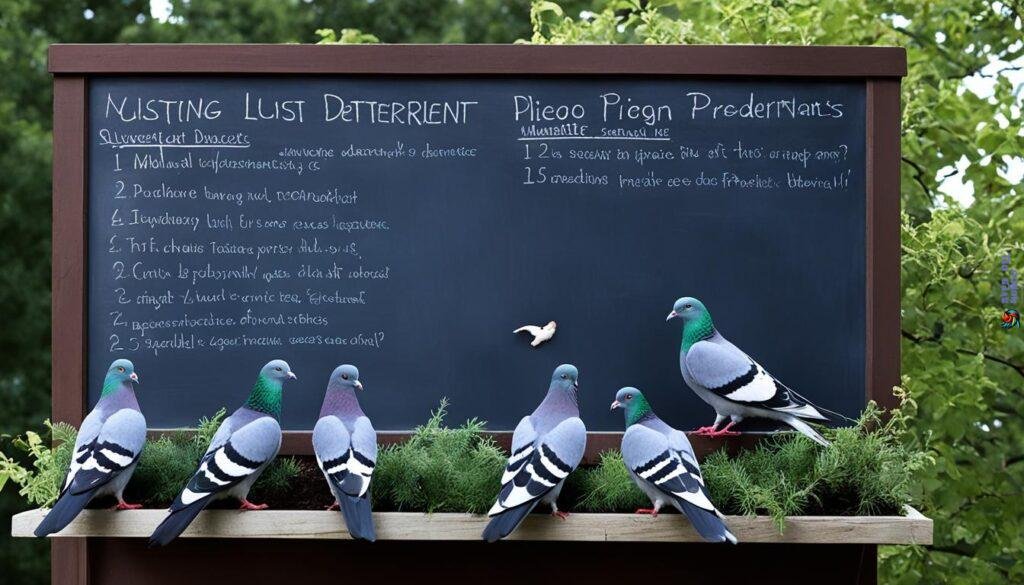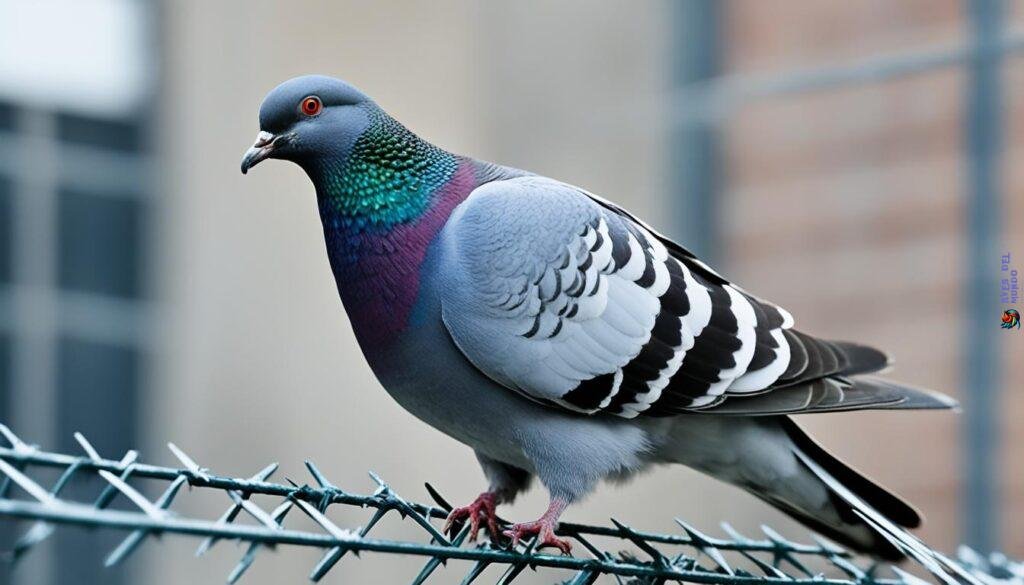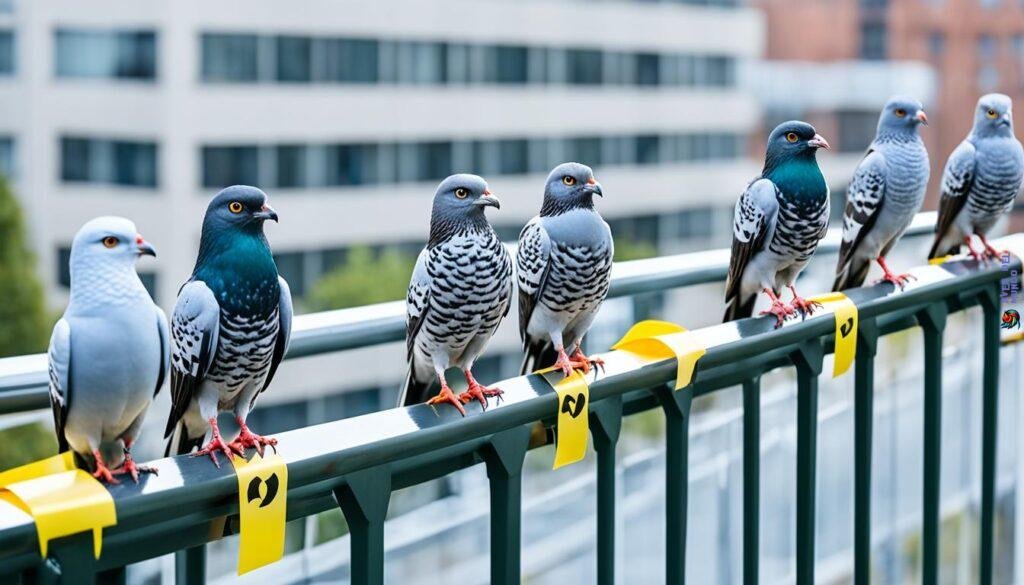Did you know that pigeons are one of the most common bird species in urban areas, with populations reaching millions in some cities?
If you are dealing with a pigeon problem on your residential or commercial property, you’re not alone. These birds can cause significant damage to buildings, create unsightly messes, and pose health risks. Fortunately, there are several effective pigeon control methods and deterrent options available to help you get rid of pigeons and prevent them from returning.
In this article, we will explore various pigeon exclusion techniques, pigeon removal strategies, and pigeon prevention tips. Whether you’re looking for humane pigeon control methods or want to take a DIY approach, we’ve got you covered. Let’s dive in and discover the most effective ways to manage pigeon populations and keep your property pigeon-free!
Culling Pigeons
When it comes to dealing with a pigeon infestation, culling is one method that is often considered. Culling involves the intentional reduction of the pigeon population through various means, including shooting, poisoning, using traps, and even employing raptors for pigeon control.
Note: Culling pigeons may provide an immediate solution, but it is important to understand that it is generally prohibited in public areas and should only be carried out in compliance with applicable laws and regulations. Additionally, culling represents more of a harvest approach rather than a long-term control program.
If you are considering culling pigeons, it is crucial to carefully evaluate the legal requirements, ethical considerations, and potential effectiveness of each method. It is recommended to consult with local authorities, pest control professionals, or wildlife management experts to ensure proper and humane pigeon control practices.
Shooting Pigeons
Shooting pigeons is a direct method of reducing their population. It requires skill, precision, and expertise in handling firearms. While it can be effective in specific situations, shooting pigeons must only be done in designated areas and with the necessary permits and licenses. It is essential to prioritize safety and minimize the risk of unintentional harm to people or other animals.
Poisoning Pigeons
Poisoning pigeons involves the use of toxic substances to eliminate them. However, this method is highly discouraged due to the potential risks it poses to non-target species, including domestic pets, wildlife, and even humans. It may also raise legal and ethical concerns. It is crucial to remember that using regulated pesticides or toxins requires compliance with local regulations and should only be carried out by licensed professionals.
Traps for Pigeons
Trapping pigeons is another approach for culling their population. Various types of traps can be used, such as live capture traps or lethal traps. Live capture traps allow for the relocation of pigeons to a more suitable location, while lethal traps result in the pigeons’ immediate termination. When using traps, it is essential to follow appropriate guidelines and check local regulations, especially when it comes to the handling, release, or disposal of trapped pigeons.
Raptors for Pigeon Control
Raptors, such as trained falcons or hawks, can be employed as a natural method of controlling pigeons. These birds of prey act as deterrents, using their presence and hunting instincts to scare away or capture pigeons. Falconry-based pigeon control programs are often implemented in large public spaces, agricultural areas, or commercial buildings. However, they require special training, permits, and continuous monitoring to ensure the safety and well-being of both the raptors and the targeted pigeons.
While culling pigeons may seem like a direct solution, it is essential to consider the potential implications and explore alternative methods that prioritize long-term pigeon control strategies with a focus on humane practices.
| Culling Method | Pros | Cons |
|---|---|---|
| Shooting Pigeons | – Immediate reduction of pigeon population – Can be effective in specific areas | – Requires permits and licenses – Potential safety hazards – Limited long-term control |
| Poisoning Pigeons | – Rapid elimination of pigeons | – Risks to non-target species – Legal and ethical concerns – Potential harm to the environment |
| Traps for Pigeons | – Allows for relocation of pigeons – Provides control options | – Requires careful handling and disposal – Monitoring compliance with regulations |
| Raptors for Pigeon Control | – Natural method – Acts as a deterrent | – Requires specialized training and permits – Continuous monitoring and management |
Reducing Pigeon Reproduction
Are you tired of dealing with the constant presence of pigeons on your property? One effective approach to tackle this issue is by reducing their reproduction. By implementing measures such as pigeon birth control, nest destruction, and the installation of dovecotes combined with egg removal or replacement, you can gradually and predictably decrease the pigeon population.
Pigeon Birth Control: Controlling pigeon reproduction is a key step in managing their population. By using pigeon birth control methods, you can prevent pigeons from breeding and multiplying. These methods typically involve the use of feeding stations that dispense contraception specifically designed for pigeons. The contraceptive bait disrupts their reproductive cycle and reduces their ability to lay fertilized eggs.
Nest Destruction: Pigeons are known for their strong attachment to their nests. By removing or destroying their nests, you make your property less appealing and discourage pigeons from returning. Regularly inspecting your property for pigeon nests and removing them promptly is crucial in reducing their reproduction and population size.
Dovecotes and Egg Removal/Replacement: Installing dovecotes, which are specially designed structures that provide alternative nest locations for pigeons, can help control their population. Pigeons prefer nesting in elevated areas, such as rooftops and ledges. By offering designated nest sites, you can encourage pigeons to nest in the dovecotes rather than on your property. Additionally, regularly removing or replacing pigeon eggs in the nests can decrease hatching success rates, further reducing pigeon reproduction.
While these methods may require time and persistence to achieve desired results, they offer a humane and effective approach to managing pigeon populations without resorting to more drastic measures.

| Methods to Reduce Pigeon Reproduction | Effectiveness | Difficulty |
|---|---|---|
| Pigeon Birth Control | High | Moderate |
| Nest Destruction | Medium | Low |
| Dovecotes and Egg Removal/Replacement | High | High |
Physically Excluding Pigeons
To physically exclude pigeons from your property, there are several effective methods that can be used. These include:
- Spikes for Pigeons: Installing bird spikes on ledges, windowsills, and other surfaces where pigeons commonly roost can prevent them from landing and perching. The spikes create an uncomfortable surface for the birds, encouraging them to seek another location.
- Bird Wires for Pigeons: Bird wires can be installed to create a barrier that prevents pigeons from landing and roosting on buildings or structures. The wires are barely visible and do not harm the birds. They simply create an obstacle that discourages pigeons from loitering.
- Slides for Pigeons: Slides are angled surfaces that can be strategically placed on ledges and beams to prevent pigeons from gaining a foothold. The smooth surface makes it difficult for the birds to grip and roost, effectively deterring them from the area.
- Shock Tracks for Pigeons: Shock tracks emit a mild electric shock when pigeons come into contact with them. This harmless shock conditions the birds to avoid the area, effectively preventing them from perching or roosting.
These physical exclusion methods are highly effective in keeping pigeons away from your property. While they may require professional installation and be more costly than other deterrent options, they provide long-lasting results.

Comparison of Physical Exclusion Methods for Pigeons
| Method | Pros | Cons |
|---|---|---|
| Spikes | Effective deterrent | Visible, may require ongoing maintenance |
| Bird Wires | Inconspicuous, humane | Professional installation required |
| Slides | Prevents pigeons from gaining foothold | May require precise positioning |
| Shock Tracks | Conditions pigeons to avoid the area | Requires professional installation, higher cost |
Using Deterrents
When it comes to pigeon control, deterrents can be an effective solution. Here are some deterrent options that can help you get rid of pigeons:
- Sonic Deterrents: Sonic emitters emit distress calls or predator sounds that scare away pigeons. The noise disrupts their roosting patterns and discourages them from returning to the area. These deterrents can be especially effective in open spaces or outdoor areas.
- Ultrasonic Deterrents: Ultrasonic emitters produce high-frequency sound waves that are inaudible to humans but cause discomfort to pigeons. This deterrent method creates an uncomfortable environment for the birds, encouraging them to leave and find a more peaceful location.
- Effigies: Effigies such as plastic owls or rubber snakes can be placed in areas where pigeons commonly gather. The sight of these predator replicas can intimidate pigeons and deter them from roosting or nesting in that location. However, it is important to regularly move the effigies to prevent pigeons from becoming accustomed to their presence.
- Light Sources: Pigeons are naturally drawn to well-lit areas. By using reflected and direct light sources strategically, you can disrupt their preferred roosting spots. This can be done by installing motion-activated lights, reflective tape, or even laser devices that project moving patterns to deter pigeons from settling in the area.
- Propane Cannons: Propane cannons create loud noise and emit bursts of flames to scare away pigeons. The sudden noise and visual impacts created by these devices can startle and repel pigeons. However, they should be used with caution and in compliance with local regulations.
- Trained Raptors: Trained raptors, such as hawks or falcons, can be used as natural deterrents to control pigeon populations. These birds of prey instinctively hunt pigeons, creating a fear response that encourages pigeons to avoid the area. Hiring a professional falconer or raptor handler can ensure the safe and effective use of trained raptors for pigeon control.
While these deterrent methods can be effective, it is important to note that pigeons may acclimate to them over time. To maximize their effectiveness, it is recommended to combine various deterrents and regularly rotate their use to prevent pigeons from becoming accustomed to the deterrents.

Using deterrents is one approach to pigeon control, offering a range of options to help you keep pigeons away from your property. However, for a more comprehensive and long-term solution, it is advisable to consider a combination of deterrents, exclusion methods, and reproductive control techniques.
Using Repellents
When it comes to deterring pigeons, repellents can be an effective solution. There are various types of repellents available that can make areas unattractive to pigeons, helping you maintain a pigeon-free environment.
Gels and Pastes
Gels and pastes are commonly used as bird repellents. They are applied to surfaces where pigeons typically gather, such as ledges, windowsills, and statues. The sticky texture of the gel makes it uncomfortable for pigeons to land, encouraging them to seek a different location. Regular reapplication may be necessary, especially in high-traffic areas.
Optical Gels
Optical gels are visually disruptive repellents that create an illusion of fire or water. This confuses and deters pigeons, preventing them from roosting or perching in the treated area. The reflective properties of optical gels make them effective even in low-light conditions. These gels can be used on rooftops, ledges, and other flat surfaces.
Fogs and Vapors
Fogs and vapors emit non-toxic substances that create an unpleasant environment for pigeons. These repellents typically release a harmless mist or odor that pigeons find irritating and avoid. Fogs and vapors can be applied using specialized equipment and are commonly used in large outdoor spaces, such as stadiums or parks.
It’s important to note that while repellents can be effective, they may require regular reapplication to maintain their effectiveness. Additionally, some repellents can be harmful to smaller bird species. It’s crucial to choose repellents that are safe and eco-friendly, ensuring the well-being of all birds in the area.

In the next section, we will discuss specific methods for getting rid of pigeons from different areas, such as balconies, roofs, and industrial facilities.
How to Get Rid of Pigeons from Specific Areas
If you’re dealing with pigeons in specific areas like a balcony or a roof, there are effective methods that can help you regain control. For balconies, you have several options available. You can use wires, shock tracks, netting, sound or reflected light, decoy kites, spikes, and gel repellents to keep pigeons away. These deterrents create a hostile environment that makes it undesirable for pigeons to perch or roost on your balcony.
When it comes to roofs, there are different techniques you can utilize to control pigeons. Wire coil or stainless steel wires can be installed to limit the pigeons’ access to the roof. Shock track systems are also effective in preventing pigeons from landing on your roof. Netting is another option that physically blocks pigeons from entering and nesting on your roof. Additionally, using bird gels can help create an unappealing environment for pigeons, discouraging them from choosing your roof as their home.
Pigeon control at industrial facilities often requires more comprehensive measures due to the unique challenges presented. To tackle this issue, a combination of different approaches is recommended. This may include installing physical barriers like netting and bird wires to prevent pigeons from accessing sensitive areas of the facility. Additionally, the use of deterrents such as sound devices, reflective materials, and even trained raptors can help create a hostile environment for pigeons, minimizing their presence in industrial settings.



